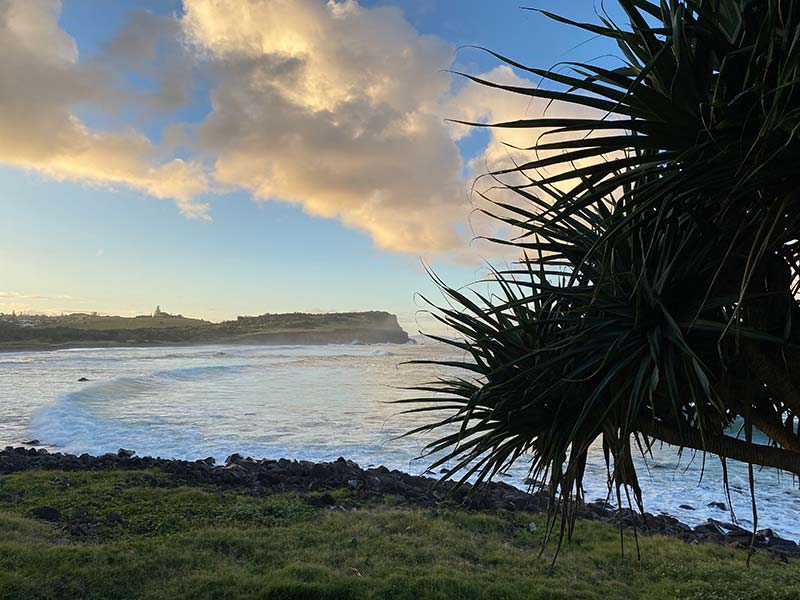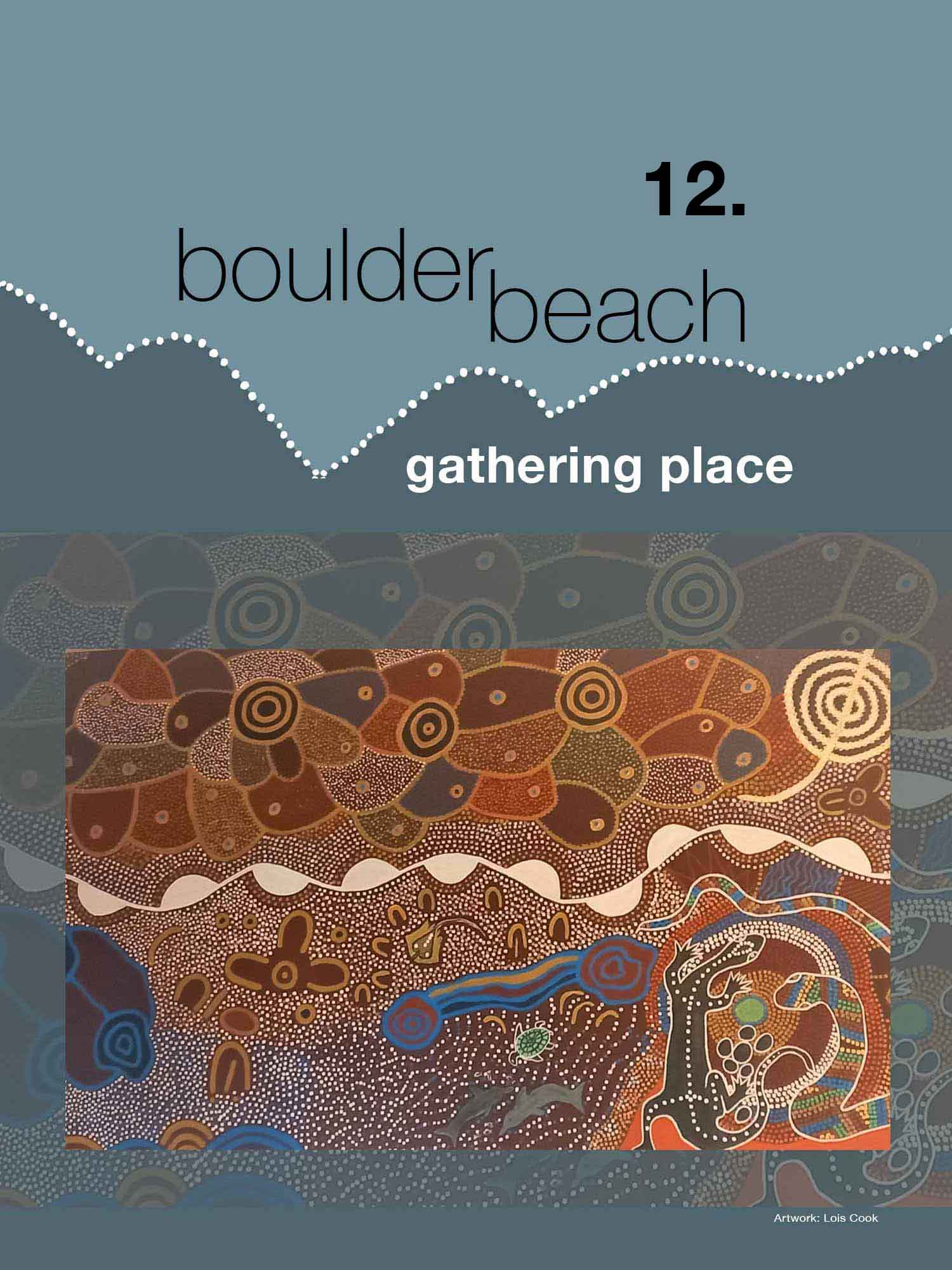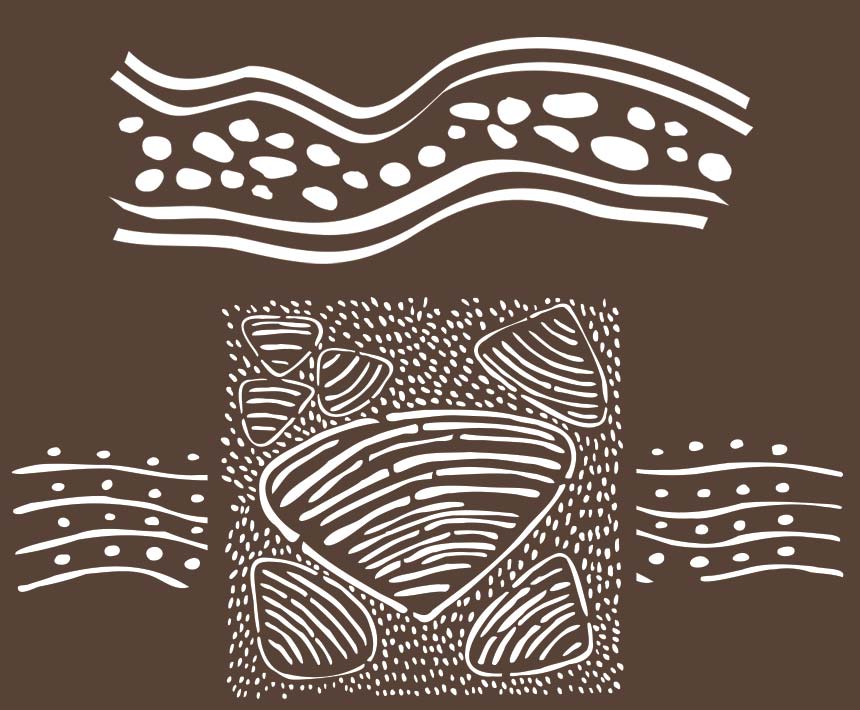The title of this artwork is Nuthungulli. The artist Lois Cook describes it as being "the story of how our people came to this place and the beginning and handing down our law/laws and culture in our nation (the beginning place, where our old people come from).
Along the Coastal Walk ...

Here the headlands offer protection from storm-driven swells running up the coast and were a natural refuge used by Aboriginal people for generations. Here they would fish and gather shell fish off the rocky platforms and the beach.
Today the accumulated shells and bones left over from these gatherings are significant sites known as middens. Middens are recognised by local Aboriginal community members as meeting places. Middens are the accumulation of debris (shells and bones) from fish, crustaceans, molluscs and other animals consumed as part of the Aboriginal diet.
Middens are often much more than just the accumulation of shells but also contain charcoal, bone, stone tools, shell artefacts such as fishhooks and scrapers, and other types of material used by Aboriginal people.
The photo below shows an eroded and exposed surface of a midden in Ballina displaying the detailed layering of shell materials.

Boulder Beach midden
The midden located near here is a significant cultural site to the Aboriginal people of Lennox Head and Ballina. Members of the local Aboriginal community, worked with archaeologists to salvage and protect the midden during construction of this walk.
The midden is connected to the broader cultural and spiritual values and places associated with within the cultural landscape of Nyangbul Country and within the Bundjalung nation in northern NSW.
It contains stone tools made from locally acquired basalt and tuff from the shoreline and imported stone materials, as well as cockle and oyster shell species such as pipi and whelk.
Middens most often occur within proximity to freshwater and saltwater sources and can be found within sand dunes, beaches, terraces above watercourses, and inland near lagoons and water holes.
These cultural middens stand out from natural shell deposits by having:
• Dark ashy soil lenses, indicating burning and use of fire;
• Fish bones and other types of crabs, molluscs and marine and freshwater creatures;
• Oysters, mussels, pipis, whelks and other mature shell species (not baby/juvenile shells);
• Broken and worn/old ‘calcined’ shells that look brittle compared to bright shiny shells that are still whole.

This is an image of an incredibly old midden in Ballina. It shows the diversity of shell species, pipi, cockle, whelk, mud mussel and oyster eaten by Aboriginal people at this place in the past. As you walk through the Boulder Beach Midden area, think about this ancient site and the families connected to it who continue to share Country with the broader community today.
Conserving artefacts
The geology of Lennox Head-Ballina is important as it tells us about what stone resources were available to Aboriginal people and what they used to make stone tools.
Stone tools are physical objects, tangible heritage, and evidence of a deep past. These tools can tell us a story about how people lived, traded, their diets and different skill levels, and their spirituality.
Can you see the large black shiny rocks on the beach and headlands eroding out of the sands and soils? This is basalt. Basalts were formed many millions of years ago and was a material used in Australia by Aboriginal people to make axe heads.

A basalt axe head pictured here [above] was recently uncovered at the Lennox Head Public School site. Although this particular axe head was made of basalt, the preferred material for stone axe heads in this area was cobble stone. The cobble stone axe shown below was one of around 280 stone tools also found at a new residential development at Skennars Head.

Today the local Aboriginal community are actively working to keep such cultural knowledge as stone tool making alive through workshops and other programs. These give people firsthand experience of the traditional ways that sustained Aboriginal community life here across countless generations.

These pictures show local Aboriginal community members Jimmy James and Anthony Cook, making stone tools using a basalt hammerstone to create flakes by striking it against a tuff core. This process is called knapping.
The flakes surrounding them were knapped off the core and show that making stone tools creates a lot of tiny pieces of stone. Stone tools are culturally significant to Aboriginal people and are protected throughout NSW as part of the National Parks and Wildlife Act, 1974.
It is an offence to harm an Aboriginal object, such as a stone tool and there are fines and imprisonment for such acts. These tools have cultural and scientific value and must be left where they are found. Culturally it is an act of desecration and extreme disrespect, to move a stone tool out of context and it has serious spiritual consequences.
If you find an Aboriginal object, leave it where it is and contact Heritage NSW or record it yourself following the information provided on the Heritage NSW website (search record Aboriginal sites).



